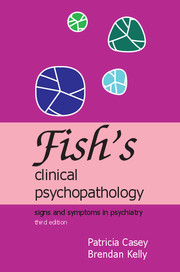Book contents
- Frontmatter
- Contents
- The authors
- Preface
- 1 Classification of psychiatric disorders
- 2 Disorders of perception
- 3 Disorders of thought and speech
- 4 Disorders of memory
- 5 Disorders of emotion
- 6 Disorders of the experience of self
- 7 Disorders of consciousness
- 8 Motor disorders
- 9 Personality disorders
- Appendix I Psychiatric syndromes
- Appendix II Defences and distortions
- Index
5 - Disorders of emotion
Published online by Cambridge University Press: 15 February 2018
- Frontmatter
- Contents
- The authors
- Preface
- 1 Classification of psychiatric disorders
- 2 Disorders of perception
- 3 Disorders of thought and speech
- 4 Disorders of memory
- 5 Disorders of emotion
- 6 Disorders of the experience of self
- 7 Disorders of consciousness
- 8 Motor disorders
- 9 Personality disorders
- Appendix I Psychiatric syndromes
- Appendix II Defences and distortions
- Index
Summary
It is customary to distinguish between feelings and emotions. A feeling can be defined as a positive or negative reaction to some experience or event and is the subjective experience of emotion. By contrast emotion is a stirred-up state caused by physiological changes occurring as a response to some event and which tends to maintain or abolish the causative event. The feelings may be those of depression, anxiety, fear, etc. Mood is a pervasive and sustained emotion that colours the person's perception of the world. Descriptions of mood should include intensity, duration and fluctuations as well as adjectival descriptions of the type. Affect, meaning short-lived emotion, is defined as the patient's present emotional responsiveness. It is what the doctor infers from the patient's body language including facial expression and it may or may not be congruent with mood. It is described as being within normal range, constricted, blunt or flat.
The classification and description of moods and emotion is bedeviled by the fact that the same terminology is used to describe those that are normal and appropriate (indeed their absence might be considered abnormal) and those that are so pathological as to warrant hospitalisation. Terms, such as depression, anxiety, etc., are examples of similar words being used for normal emotional reactions and for disorders requiring treatment. This failure to differentiate has serious implications, since not only does it cause linguistic confusion but it fails to distinguish the normal from the abnormal.
In this chapter, five levels of emotional reaction and expression that have clinical relevance will be described. The term normal emotional reactions will be used to describe emotional states that are the result of events and that lie within cultural and social norms. Abnormal emotional reactions are those that are understandable but excessive, while abnormal expressions of emotion refer to emotional expressions that are very different from the average normal reaction. Morbid disorders of emotional expression differ from abnormal expressions of emotion in that the person is unaware of the abnormality. Finally there will be a brief overview of morbid disorders of emotion.
Classification
Normal emotional reactions
Some emotional reactions are normal responses to events or to primary morbid psychological experiences.
- Type
- Chapter
- Information
- Fish's Clinical PsychopathologySigns and Symptoms in Psychiatry, pp. 65 - 74Publisher: Royal College of PsychiatristsPrint publication year: 2007



